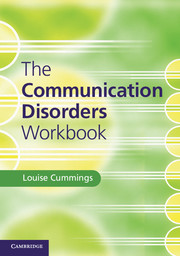Book contents
- Frontmatter
- Contents
- Preface
- Acknowledgements
- List of data analysis exercises
- Chapter 1 Introduction to communication disorders
- Chapter 2 Developmental speech disorders
- Chapter 3 Developmental language disorders
- Chapter 4 Communication disorders in mental illness
- Chapter 5 Acquired speech disorders
- Chapter 6 Acquired language disorders
- Chapter 7 Disorders of voice
- Chapter 8 Disorders of fluency
- Chapter 9 Hearing disorders
- Answers to questions and exercises
- Glossary
- References
- Index
Preface
Published online by Cambridge University Press: 05 June 2014
- Frontmatter
- Contents
- Preface
- Acknowledgements
- List of data analysis exercises
- Chapter 1 Introduction to communication disorders
- Chapter 2 Developmental speech disorders
- Chapter 3 Developmental language disorders
- Chapter 4 Communication disorders in mental illness
- Chapter 5 Acquired speech disorders
- Chapter 6 Acquired language disorders
- Chapter 7 Disorders of voice
- Chapter 8 Disorders of fluency
- Chapter 9 Hearing disorders
- Answers to questions and exercises
- Glossary
- References
- Index
Summary
The clinical education of students in speech and language therapy (SLT) involves a demanding curriculum encompassing knowledge of linguistic and medical disciplines alongside the development of more practically oriented skills. Within this curriculum, there is often little time to develop the analytical skills which SLT students must possess in order to characterize communication disorders. These skills include the ability to characterize the phonetic and phonological processes which underlie disordered speech in cleft palate, the errors in morphosyntax of children with specific language impairment, the impairments in lexical semantics in adults with aphasia, and the pragmatic and discourse anomalies of clients with schizophrenia. The development of these skills is often only possible after many hours of practice in working with actual clinical data. However, the time constraints of most SLT curricula limit the extent to which this level of practical experience can be achieved. It is with a view to resolving this dilemma for clinical educators that this volume has been devised.
This workbook aims to give SLT students extensive practice in identifying and characterizing the full range of communication disorders which are part of the clinical caseload of speech and language therapists. No communication disorder or clinical population is omitted from consideration. Also, impairment or breakdown at each level of linguistic analysis is included, from phonetics, phonology and morphology to syntax, semantics, pragmatics and discourse. Spoken and written language disorders are examined as are aspects of non-verbal communication. Students will learn to characterize expressive and receptive impairments of communication, the clinical features of a range of pathologies with implications for communication and also develop their knowledge of the aetiology of communication disorders. The volume contains 330 short-answer questions and 60 data analysis exercises, each of which poses five questions. So, in total, there are over 600 questions which challenge students on different aspects of communication disorders. All questions are accompanied by answers so that students can check their understanding and monitor their performance. A glossary and suggestions for further reading are additional features of the text which will also facilitate student learning. The glossary is particularly detailed and contains not just communication disorders terminology, but also a range of related clinical terms and expressions.
- Type
- Chapter
- Information
- The Communication Disorders Workbook , pp. ix - xPublisher: Cambridge University PressPrint publication year: 2014



